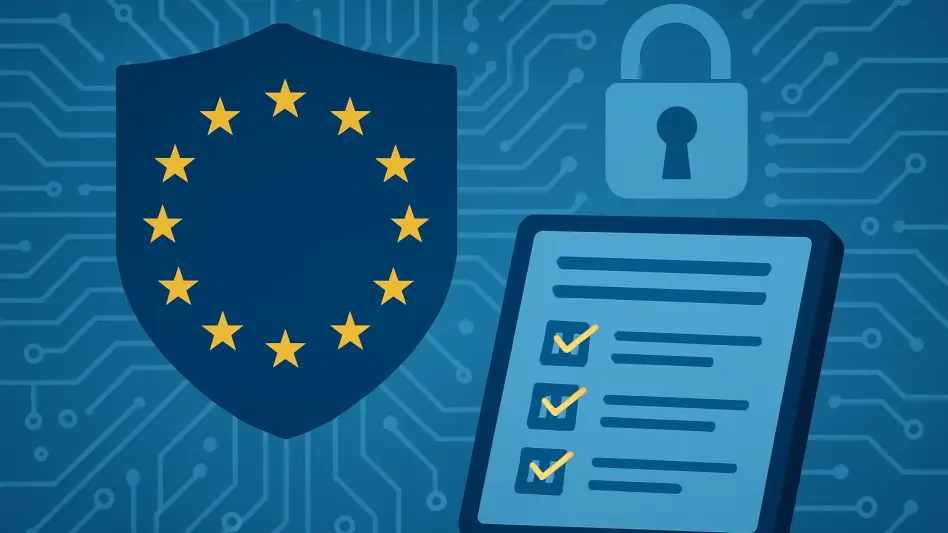In an era where cyber threats loom larger than ever, the European Union has introduced a transformative piece of legislation known as the Cyber Resilience Act (CRA), which took effect on December 10, 2024, with full implementation slated for December 11, 2027. This regulation is a game-changer for businesses dealing with digital products in the EU, mandating stringent cybersecurity measures across a vast array of hardware and software—from everyday laptops to internet-connected baby monitors. The stakes couldn’t be higher, as vulnerabilities in these products can compromise consumer safety, disrupt critical infrastructure, and erode trust in the digital marketplace. For companies operating in or exporting to the EU, this act serves as a critical wake-up call to evaluate their current practices and prepare for a seismic shift in compliance requirements. Ignoring these mandates risks not only market access but also severe financial and reputational damage, making it imperative to understand the implications now.
The CRA isn’t just another regulatory hurdle; it’s a strategic opportunity to enhance consumer trust by prioritizing security and transparency. With cyber incidents escalating in frequency and sophistication, this legislation aims to fortify the digital ecosystem by ensuring that products are secure by design and throughout their lifecycle. Businesses that adapt early can turn compliance into a competitive advantage, demonstrating their commitment to safety in a market increasingly sensitive to cybersecurity concerns. However, the path to alignment is fraught with complexity, as the regulation categorizes certain products as “important” or “critical,” imposing stricter scrutiny on those with higher risk profiles. With less than three years until full enforcement, the urgency to act is palpable—companies must start aligning their processes to avoid costly disruptions and penalties that could reach millions of euros. This is a pivotal moment for stakeholders to reassess their approach and build resilience into their operations.
Understanding the Cyber Resilience Act
What Is the CRA and Why Does It Matter?
The Cyber Resilience Act stands as a landmark regulation crafted by the European Union to bolster cybersecurity for products with digital elements entering its market. It addresses a pressing reality: as the world becomes increasingly digitized, vulnerabilities in hardware and software pose significant threats to individuals, enterprises, and essential services. The CRA’s primary mission is to reduce these risks by embedding robust security standards into the design, development, and maintenance of digital products. Beyond protecting end-users, this act seeks to safeguard the integrity of the broader digital economy, where a single breach can cascade into widespread disruption. Its comprehensive approach signals the EU’s determination to lead globally in cybersecurity governance, setting a precedent that could influence regulations worldwide. For businesses, understanding the CRA’s intent is the first step toward navigating its demands and ensuring continued access to one of the world’s largest markets.
At its core, the significance of the CRA lies in its proactive stance against the evolving landscape of cyber threats, which have grown more sophisticated with the proliferation of connected devices. Unlike previous guidelines that were often voluntary, this regulation imposes mandatory requirements, ensuring that cybersecurity is no longer an afterthought but a fundamental component of product development. This shift is particularly crucial for protecting critical infrastructure, where compromised devices could have catastrophic consequences. The act also fosters greater consumer confidence by promoting transparency about security features and risks associated with digital products. As companies grapple with these new expectations, the CRA challenges them to rethink their operational models, balancing compliance with innovation. Failure to adapt could mean exclusion from the EU market, making this regulation a defining factor in shaping business strategies over the coming years.
Who Is Affected by the CRA?
The scope of the Cyber Resilience Act is remarkably broad, casting a wide net over various players in the digital product ecosystem within the EU. Manufacturers, importers, and distributors of hardware, software, and remote data processing solutions all fall under its purview, regardless of whether they are based in the EU or simply market their products there. This includes everyday consumer items like laptops, tablets, and VR headsets, as well as more specialized products such as internet-connected toys and baby monitors. The regulation’s reach extends across both consumer and industrial sectors, ensuring that no segment of the digital market escapes scrutiny. This expansive applicability underscores the EU’s commitment to creating a uniformly secure digital environment, holding every link in the supply chain accountable for maintaining high cybersecurity standards.
Beyond the obvious targets, the CRA also impacts businesses that might not immediately recognize their inclusion under its framework. For instance, companies providing cloud functionalities for smart devices or software updates for existing products are equally subject to its requirements. The act’s definition of “products with digital elements” encompasses a vast array of offerings, from microprocessors to complex operating systems, illustrating its intent to address vulnerabilities at every level of technology. This inclusivity means that even smaller enterprises or niche providers must prepare for compliance, as exemptions are limited and the consequences of oversight are severe. The shared responsibility among manufacturers, importers, and distributors also creates a ripple effect, compelling collaboration across the supply chain to meet the regulation’s rigorous demands. Understanding this interconnected accountability is vital for any business aiming to maintain a foothold in the European market.
Key Obligations Under the CRA
Lifecycle Cybersecurity Requirements
Under the Cyber Resilience Act, manufacturers bear the primary burden of integrating cybersecurity into every phase of a product’s lifecycle, from initial design through to post-market maintenance. This comprehensive approach mandates thorough risk assessments to identify potential vulnerabilities before a product reaches consumers, alongside ongoing efforts to mitigate any issues that arise during its use. Compliance also involves meeting essential cybersecurity requirements, preparing detailed technical documentation, and conducting conformity assessments to verify adherence to standards. For products classified as “important” or “critical”—such as password managers or smartcards—stricter evaluation processes apply, reflecting their heightened security implications. The goal is to prevent products with known vulnerabilities from entering the market, ensuring safety and reliability at every stage. This lifecycle focus represents a significant shift, requiring companies to embed security as a core principle rather than a reactive measure.
Additionally, the CRA emphasizes sustained responsibility beyond the point of sale, obligating manufacturers to provide support and updates for a defined period after a product’s release. This includes addressing newly discovered vulnerabilities and ensuring users have access to clear instructions for secure usage. The regulation’s insistence on affixing CE markings to compliant products serves as a visible assurance of adherence to EU standards, while also facilitating market surveillance. For businesses, this means retooling development processes to prioritize long-term security commitments, a task that demands both resources and foresight. The tiered scrutiny for “important” and “critical” products further complicates compliance, as misclassification or inadequate preparation could lead to delays or market exclusion. Adapting to these lifecycle requirements is not just about meeting legal obligations but also about building consumer trust through demonstrable dedication to safety.
Responsibilities Across the Supply Chain
The Cyber Resilience Act extends accountability beyond manufacturers to include importers and distributors, creating a shared framework for compliance across the supply chain. Importers must ensure that manufacturers have fulfilled their obligations, verifying the presence of necessary documentation and conformity assessments before introducing products to the EU market. Distributors, similarly, are tasked with confirming that products bear the appropriate markings and come with required user instructions. This collaborative approach aims to prevent non-compliant goods from reaching consumers, reinforcing the regulation’s goal of a secure digital marketplace. The burden of verification underscores the importance of robust partnerships and communication among all parties involved, as any lapse at one stage could jeopardize the entire chain’s compliance status. This interconnected responsibility is a cornerstone of the CRA’s strategy to enforce uniform standards.
Moreover, the regulation imposes strict reporting obligations for incidents and vulnerabilities, ensuring rapid response to potential threats. Manufacturers must notify the European Union Agency for Cybersecurity (ENISA) and relevant national authorities within 24 hours of becoming aware of actively exploited vulnerabilities or severe incidents, followed by updates within 72 hours and final reports within 14 days or a month, depending on the issue’s nature. Users must also be informed promptly to mitigate risks. These tight timelines reflect the EU’s emphasis on transparency and swift action, placing significant pressure on businesses to establish efficient monitoring and communication systems. Non-compliance with these reporting requirements can attract severe penalties, amplifying the need for proactive incident management. For importers and distributors, staying informed about these processes is equally critical, as their role in the supply chain ties directly to the manufacturer’s adherence to such mandates.
Preparing for Compliance
Assessing Product Scope and Classification
A critical first step for businesses navigating the Cyber Resilience Act is to determine whether their offerings fall within its scope, a process that requires a detailed evaluation of product categories and functionalities. The regulation applies to a wide range of products with digital elements, encompassing both hardware like motherboards and software like applications, as well as cloud-based solutions for smart devices. Everyday items such as tablets and internet-connected toys are included, alongside more specialized equipment, illustrating the act’s extensive reach. Beyond identifying applicability, companies must ascertain if their products are classified as “important” or “critical,” categories that trigger heightened scrutiny due to their potential impact on security. For example, password managers and smartcards face stricter conformity assessments, reflecting their sensitive nature. Understanding these classifications is essential, as they dictate the level of compliance effort required and shape the preparatory timeline.
Equally important is the recognition that misclassification or overlooking a product’s inclusion under the CRA can lead to significant setbacks, including market delays or penalties. Businesses must undertake a meticulous review of their product portfolios, consulting regulatory guidance or expert advice to ensure accuracy in scope determination. This process also involves assessing the specific cybersecurity risks associated with each item, as the regulation prioritizes tailored risk management over a one-size-fits-all approach. The European Commission retains the authority to update classifications over time, adding a layer of complexity that necessitates ongoing vigilance. By starting this assessment early, companies can avoid last-minute scrambles and allocate resources effectively to meet the regulation’s demands. This proactive step not only mitigates compliance risks but also positions businesses to adapt swiftly to any evolving categorizations or requirements before the full implementation deadline.
Building a Compliance Roadmap
With the full application of the Cyber Resilience Act set for December 11, 2027, developing a structured compliance roadmap is imperative for businesses aiming to meet its rigorous standards without disrupting operations. This plan should outline key milestones, starting with a gap analysis to identify discrepancies between current practices and the regulation’s requirements, such as inadequate risk assessment processes or insufficient technical documentation. Establishing clear timelines for integrating cybersecurity into product design, conducting conformity assessments, and training staff on new protocols is crucial. The roadmap must also account for the unique challenges posed by “important” or “critical” product classifications, ensuring that enhanced scrutiny is addressed through robust internal controls. Early planning allows for iterative adjustments, reducing the likelihood of costly delays or non-compliance as the deadline approaches. A well-defined strategy serves as a blueprint for seamless alignment with the EU’s expectations.
Furthermore, a compliance roadmap should prioritize collaboration across departments and with external partners to ensure all aspects of the supply chain are prepared for the CRA’s mandates. This includes engaging with importers and distributors to verify shared responsibilities and setting up systems for rapid incident reporting to authorities like ENISA. Regular audits and mock assessments can help identify potential weaknesses before they become liabilities, while allocating budget for technological upgrades or expert consultations can streamline the transition. The roadmap must also anticipate potential regulatory updates from the European Commission, building flexibility into timelines to accommodate changes. By embedding these elements, businesses can transform compliance from a burden into an opportunity to enhance their cybersecurity posture. Looking back, those who acted decisively in these preparatory stages found themselves better equipped to navigate the complexities of enforcement, avoiding the pitfalls that ensnared less proactive competitors.








